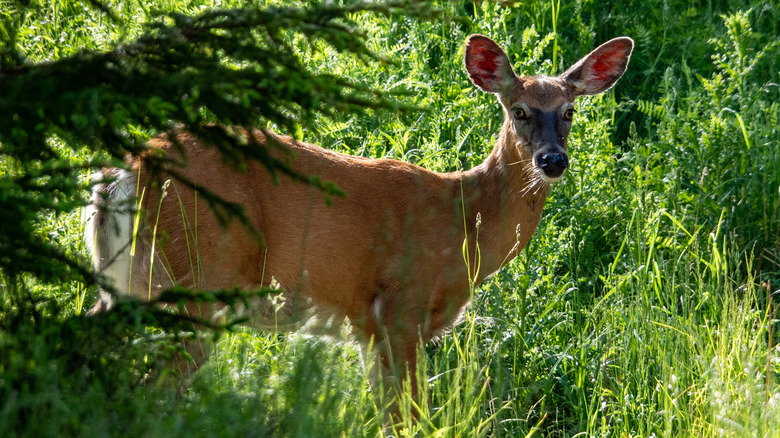Local Wildlife You'll Likely See On A Trip To The Gorgeous Acadia National Park
Maine is a sparsely populated yet unique U.S. state with quaint, picturesque towns and gorgeous landscapes. A major draw for this nature-filled state is Acadia National Park, and some of the most breathtaking views in New England, with rocky ocean overlooks and wooded paths, are found in and around this park. Visitors have been enjoying the sites here since the 1800s, as shown by the historic carriage roads commissioned by famed New York City businessman John D. Rockefeller. In the 21st century, more than just those on the country's rich list can visit the area, but even with increased foot traffic, Acadia National Park is still a nature and wildlife lover's dream.
The animals who call Acadia National Park home range from small to large and from the treetops to the waters. Deer, rabbits, ospreys, bats, and even harbor seals are just a few of the creatures in this part of the country. Some of the park's animals are quite stealthy, but there are plenty of places to visit within the park to catch glimpses of them in one of the best national parks on the East Coast.
The best chances to see Acadia's white-tailed deer are sunrise and sunset
Let's start with Acadia National Park's major land mammals. While moose tend to stay closer to Maine's border with New Hampshire or elsewhere further inland, Acadia National Park has some rare sightings of North America's tallest land animal. More common in the national park is the white-tailed deer. Look for these elegant herbivores as the sun rises or sets, especially on the carriage roads or around Sieur de Monts. Sieur de Monts is an area of the park near wooded walking trails like Jesup Path and the delightful native plant-shrouded Wild Gardens of Acadia. A white-tailed deer sighting here would be like icing on the cake.
If you do not see any beavers while in Acadia National Park, you will likely see evidence of them as you pass by trees that they have nibbled and removed for their dams and homes. These stumps are common around Jordan Pond toward the middle of the park or the Tarn (another pond) just south of the Wild Gardens of Acadia. Beavers are also found around Witch Hole Pond, but this area is not as centrally located. Other mammals throughout the park include raccoons, minks, otters, and bobcats.
Enjoy Acadia's wildlife up close in tide pools, but be gentle
Acadia National Park is also one of America's popular birdwatching destinations. While you look for beavers at Jordan Pond, look and listen for loons floating along the waters, and scan the nearby treetops for eagles. You can use Cadillac Summit Road to get close to Cadillac Mountain and the area's North Ridge Trail, wherein you may spot hawks in the fall months. Among the other predators of the air in Acadia are ospreys, falcons, and owls, and the park is also home to scavenging vultures.
Some of Acadia National Park's water dwellers find themselves in small tide pools on Wonderland Trail, Bar Island Trail, and the more remote but still drivable Schoodic Peninsula connected to mainland Maine. Begin exploring these ecosystems around 90 minutes before low tide begins to see anemones, starfish, and more, but do so carefully and avoid touching them, as these creatures are delicate. The U.S. Harbors is useful, with updates on when low tides occur. For open-water animals like harbor seals, book a Sea Princess Cruise departing from Northeast Harbor on the outskirts of Acadia National Park. Boat tours also help you view birds like puffins and terns that nest along Acadia's cliffs. Remember to bring binoculars to get a good view of all the incredible wildlife throughout the park!


